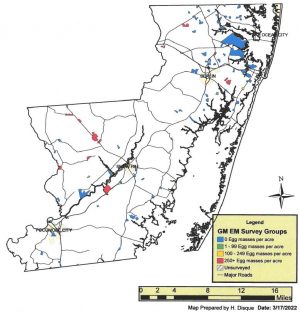
SNOW HILL– More than 3,000 acres in Worcester County will be treated for spongy moths following recent pest surveys.
The Maryland Department of Agriculture (MDA) advised Worcester County this week that the agency would be treating 3,082 acres to suppress the population of spongy moths—the insects formerly known as gypsy moths.
“The spongy moth devastates hardwoods,” said Weston Young, the county’s chief administrative officer.
MDA has been monitoring spongy moths—which entomologists agreed to rename last year to eliminate an ethnic slur—in Worcester County since the 1980s. The agency conducts egg mass surveys on a yearly basis. Between August and December 2021, state officials conducted 145 spongy moth egg mass surveys in Worcester County, with 105 of those on private land and 40 on state land. Those surveys identified 15 areas in the county with “potentially damaging” populations.
“When such infestation levels do occur, alternatives are considered area by area, including suppression with aerial application of insecticide,” MDA’s 2021 Spongy Moth Egg Mass Survey Report reads. “MDA has proposed treatment on 14 privately owned areas and one state land totaling 3,082 acres for 2022 in Worcester County and an additional 4,354 acres in Somerset and Wicomico counties.”
Suppression activities are done in cooperation with county governments. In the coming year, Worcester will spend $73,935—up from $1,700 in the current fiscal year—to attempt to suppress the moths.
“What we pay is a match,” Young said. “Their amount has gone up drastically as well.”
According to state officials, while there is a fungus that has a negative impact on spongy moth populations, it was not found infecting any caterpillar populations in Worcester County. As a result, the upcoming treatment is critical in suppressing moth population.
“Spongy moth populations are currently low throughout much of Maryland,” the survey report reads. “Building populations were found in Somerset, Worcester and Wicomico counties. And, it only takes a season or two of favorable conditions for potentially defoliating levels to return. Sot it is important to monitor the populations on a yearly basis to recognize changes, and make timely and appropriate recommendations to land owners and managers.”
In addition to monitoring spongy moths, the state also surveys for beech leaf disease, invasive wood wasps, emerald ash borers, redbay ambrosia beetles, southern pine beetles and walnut twig beetles. None of those were found in Worcester County in 2021.

